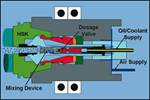Toward More Seamless MQL
One of the small perils of a new technology is that it often involves new steps or new considerations that present special opportunities for error. Minimum quantity lubrication (MQL) is a technology that exemplifies this point.
One of the small perils of a new technology is that it often involves new steps or new considerations that present special opportunities for error. Minimum quantity lubrication (MQL) is a technology that exemplifies this point.
This “semi-dry” approach to machining, which uses a minimum quantity of lubricant that is mixed with air and delivered through the tool, is still a relatively new idea, particularly in North America. One element peculiar to this process is a screw within the MQL toolholder that seals against the tool shank to create a continuous channel for coolant delivery. If the holder is shrink fit, then this screw has to be backed away during heating and cooling. After the cooling and clamping, if the operator forgets to tighten the screw, then the lubricant supply to the tool will be impaired, and MQL may appear to have failed.
Zoller (Ann Arbor, Michigan) has now automated this step. The supplier of tool measuring machines offers a combination heat-shrink system developed specifically for MQL shrink-fit holders. As part of a cycle for clamping and measuring the tools in these holders, the machine automatically retracts the holder’s MQL screw before clamping, then tightens it into place after the tool is secure.
Zoller engineer Martin Zepter says the potential value of the device goes beyond error-proofing. Moving the same servo-controlled rod that turns the screw, the machine can also set the tool to a nominal length. That is, the user can specify a length instead of measuring it after the fact.
To achieve this nominal length, the machine measures the tool before clamping, as the tool sits within a special fixture piece mated to the small bore of the still-cool holder. The system then uses this measurement to set the position of the rod, which moves through the holder and through the hole in the MQL screw to support the tool at the user-chosen extension length. After the tool is clamped, the rod moves to grip the screw with its flanges and rotate the screw into position.
Tool measurements used for this nominal setting are taken cold, Mr. Zepter notes, so thermal effects do not influence the measurement. Precise tool setting to predetermined lengths is particularly important for toolholders used in multiple-spindle machining centers that incorporate a single set of axis moves to machine multiple parts simultaneously. With this presetter system, it is possible to use shrink-fit MQL holders on these machines.
Yet another advantage of the system relates to the screw itself, Mr. Zepter says. When the unit tightens the screw, a slip clutch is involved, so the screw is always tightened to the correct torque. This eliminates yet another possible error—over-tightening the screw, which can compromise the life of the holder.
Related Content
-
IMTS Takeaways From the Modern Machine Shop Editorial Team
The first in-person IMTS in four years left the MMS editorial staff with a lot to digest. Here are a few of our takeaways from the show floor.
-
All-Around Mill Improves Productivity and Cost for Valve Job
Adopting a mill with a double-negative rake and pockets compatible with multiple insert geometries enabled Progressive Metal Service to increase feed and lower scrap rates for a valve.
-
T.J. Davies Retention Knobs Maximize Cutting Tool Life
Custom-made retention knobs are sized to fit the machine tool and spindle or toolholder to extend the life of existing machine tool assets.

.jpg;width=70;height=70;mode=crop)










.png;maxWidth=300;quality=90)



